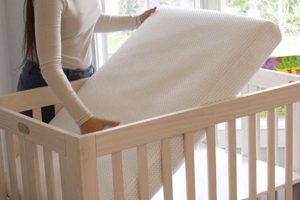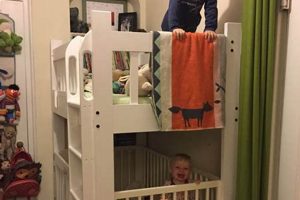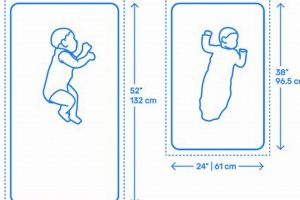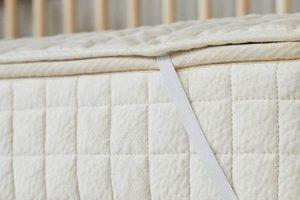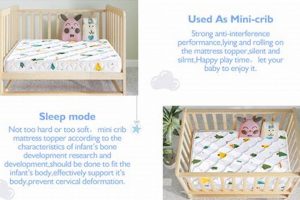A dual-sided infant sleep surface offers distinct levels of firmness tailored to different developmental stages. Typically, one side is designed to provide a firmer support for newborns, while the other offers a slightly softer surface suitable for toddlers. This adaptability aims to optimize comfort and safety as the child grows.
The key advantage lies in its prolonged usability, potentially eliminating the need to purchase a separate sleep surface as the infant transitions into toddlerhood. This can translate to cost savings and convenience for parents. Historically, the concept arose from a growing understanding of the varying support requirements of infants as they develop their skeletal and muscular systems, with the firmer side designed to reduce the risk of SIDS.
The following sections will delve into the specific materials used in construction, safety certifications to consider, and essential factors to evaluate before selecting this type of infant bedding. Further examination will cover maintenance guidelines and address frequently asked questions regarding its use.
Selecting a Dual-Sided Infant Sleep Surface
The selection of appropriate bedding for infants requires careful consideration of several factors to ensure safety and optimal developmental support. The following guidelines provide crucial insights into evaluating and utilizing a dual-firmness infant sleep surface.
Tip 1: Prioritize Safety Certifications: Verify that the product has been certified by reputable organizations such as CertiPUR-US or GREENGUARD Gold. These certifications indicate that the materials have been tested for harmful chemicals and emissions.
Tip 2: Assess Firmness Levels: Thoroughly evaluate the firmness of both sides. The infant side should provide a consistently firm surface to minimize the risk of suffocation and promote healthy spinal development. The toddler side should offer slightly more cushioning without compromising support.
Tip 3: Consider Material Composition: Opt for materials that are breathable and hypoallergenic. Natural latex, organic cotton, and plant-based foams can reduce the risk of allergic reactions and promote airflow.
Tip 4: Evaluate Edge Support: Ensure that the edges of the surface are reinforced to prevent sagging or compression. Strong edge support enhances stability and reduces the risk of entrapment.
Tip 5: Check for a Waterproof Cover: A waterproof or water-resistant cover is essential for protecting the core from moisture and spills. Look for covers that are easily removable and washable.
Tip 6: Confirm Size Compatibility: Verify that the dimensions of the surface are precisely compatible with the crib frame. Gaps between the surface and the crib sides can pose a safety hazard.
Tip 7: Review Warranty and Return Policies: Familiarize oneself with the manufacturer’s warranty and return policies. This provides recourse in the event of defects or dissatisfaction with the product.
Implementing these tips will aid in making an informed decision, ensuring the selected infant sleep surface provides a safe and supportive environment for the child. Key aspects include verifying safety certifications, assessing firmness, evaluating material, ensuring edge support, checking for waterproof cover, confirming size compatibility and warranty.
The concluding section will summarize the key benefits of dual-sided infant sleep surfaces and offer final recommendations for parents.
1. Firmness variability
Firmness variability is a fundamental characteristic of the two-stage crib mattress, directly addressing the changing support requirements of infants as they transition from newborn to toddler stages. This adaptability aims to optimize both safety and comfort during crucial developmental periods.
- Newborn Support and SIDS Risk Mitigation
The newborn side of a two-stage crib mattress is engineered to provide a firm, unyielding surface. This firmness is critical in reducing the risk of Sudden Infant Death Syndrome (SIDS) by preventing the infant from sinking into the mattress and potentially obstructing breathing. Real-world examples include mattresses tested to meet stringent safety standards, ensuring a consistent level of firmness across the entire surface. The implication is a safer sleep environment for the most vulnerable age group.
- Toddler Comfort and Spinal Development
The toddler side offers a slightly more cushioned surface, accommodating the increased weight and changing spinal alignment of a growing child. While softer than the newborn side, it maintains sufficient support to promote healthy spinal development and prevent excessive pressure points. Examples include mattresses utilizing memory foam or convoluted foam layers on the toddler side to enhance comfort. This allows for a more comfortable sleep as the childs musculoskeletal system matures.
- Material Composition and Firmness Control
The materials used in the construction directly influence the firmness variability. High-density foam is typically employed in the newborn side to achieve the required firmness, while the toddler side may incorporate less dense foam or padding. Examples include the use of varying densities of polyurethane foam or the inclusion of a thin layer of natural latex on the toddler side. This illustrates how material selection is intrinsically linked to achieving the desired firmness characteristics for each stage.
- Safety Standards and Firmness Testing
Regulatory bodies mandate specific firmness testing protocols to ensure that the mattress meets safety standards for both newborns and toddlers. These tests involve measuring the degree of indentation under various weight loads. Examples include compliance with ASTM standards and certifications from organizations like CertiPUR-US. Compliance with these standards validates that the firmness levels are appropriate for the intended age groups and minimizes potential hazards.
The controlled firmness variability of a dual-stage crib mattress, achieved through careful material selection, rigorous testing, and adherence to safety standards, is paramount in providing a sleep surface that adapts to the evolving needs of an infant during their critical first years. The dual design directly contributes to both safety and comfort, demonstrating a comprehensive approach to infant sleep.
2. Material composition
The material composition of a two-stage crib mattress is a crucial determinant of its safety, comfort, and longevity. The selection of materials directly influences the mattress’s firmness, breathability, hypoallergenic properties, and overall structural integrity. Cause and effect are evident: the choice of specific foams, fabrics, and adhesives dictates the physical characteristics and performance of each side of the mattress. For instance, a high-density foam core on the infant side, designed for firmness, minimizes the risk of suffocation, while a less dense memory foam layer on the toddler side enhances comfort without compromising support. The presence of potentially harmful chemicals in these materials is a risk; therefore, certification programs provide an essential check. The material composition is not merely a component but an integral foundation upon which the functionality and safety of a two-stage crib mattress are built.
Specific materials offer distinct benefits. Natural latex provides excellent support and breathability, reducing the risk of overheating. Organic cotton is hypoallergenic and minimizes exposure to synthetic chemicals. Plant-based foams represent a more sustainable and environmentally friendly alternative to traditional petroleum-based foams. Conversely, the use of low-quality or uncertified materials can lead to off-gassing of volatile organic compounds (VOCs), posing a potential health hazard to the infant. The practical application of understanding material composition lies in the ability to make informed purchasing decisions, prioritizing products that adhere to stringent safety standards and minimize exposure to potentially harmful substances. Examples of certifications to look for include CertiPUR-US, GREENGUARD Gold, and GOTS (Global Organic Textile Standard), each of which indicates testing and verification of material content and safety.
In summary, material composition is intrinsically linked to the performance and safety of a two-stage crib mattress. Prioritizing mattresses constructed from certified, hypoallergenic, and breathable materials is essential for creating a safe and supportive sleep environment for infants and toddlers. While cost may be a factor, the long-term health and well-being of the child should be the primary consideration. Challenges remain in ensuring transparency within the supply chain and educating consumers about the importance of material selection. Ultimately, informed consumer choices drive demand for safer and more sustainable products, benefiting both children and the environment.
3. Safety certification
Safety certification for dual-sided infant sleep surfaces serves as a critical validation of product adherence to established safety standards, mitigating potential hazards for infants and toddlers. These certifications represent independent verification of material composition, structural integrity, and chemical emissions, ensuring manufacturers meet minimum safety requirements.
- Chemical Emission Standards
Certifications like GREENGUARD Gold and CertiPUR-US focus on limiting Volatile Organic Compound (VOC) emissions. VOCs, released from foam and other materials, can negatively impact air quality and potentially harm infant respiratory systems. Compliance with these standards ensures minimal off-gassing, creating a healthier sleep environment. For example, a mattress certified GREENGUARD Gold has been tested for over 10,000 chemicals and VOCs, demonstrating adherence to stringent emission limits. The implication is reduced exposure to harmful airborne substances.
- Flammability Standards
CFR 1633 is a mandatory flammability standard in the United States for mattress sets. This standard dictates that mattresses must resist ignition from an open flame. Compliance often involves the use of flame-retardant materials or a flame-resistant barrier. A practical example is a two-stage sleep surface passing the CFR 1633 test, indicating it will not easily ignite if exposed to a fire source. The implications are improved fire safety and increased escape time in the event of a household fire.
- Material Safety and Content Verification
Certifications such as Oeko-Tex Standard 100 verify that materials are free from harmful levels of substances like lead, phthalates, and formaldehyde. This is particularly important for products intended for infants, who are more vulnerable to the effects of chemical exposure. A real-world example includes a mattress bearing the Oeko-Tex Standard 100 label, assuring consumers that every component, from the fabric to the thread, has been tested for harmful substances. The implication is reduced risk of allergic reactions or other adverse health effects related to chemical exposure.
- Structural Integrity and Durability Testing
While not always explicitly labeled, manufacturers often conduct internal structural integrity and durability testing. This may include assessing compression resistance, seam strength, and overall product lifespan. While the standards vary, the purpose is to ensure the mattress can withstand regular use and maintain its structural integrity over time. An example of this would be continuous use testing simulating several years of use. The implication is greater product longevity and sustained performance.
These safety certifications are instrumental in minimizing risks associated with dual-sided infant sleep surfaces. By adhering to established standards, manufacturers demonstrate a commitment to infant safety, while independent certifications offer consumers a reliable means of verifying product claims. Consumers should actively seek out mattresses with relevant safety certifications to ensure a safer and healthier sleep environment for their children.
4. Water resistance
Water resistance is a crucial characteristic of dual-stage infant sleep surfaces, directly impacting hygiene, durability, and the overall lifespan of the product. The ability to repel liquids safeguards the inner components from contamination, preventing the growth of mold and bacteria, and maintaining a sanitary sleep environment.
- Protection Against Infant Bodily Fluids
Infants and toddlers are prone to accidents involving diaper leaks, spit-up, and other bodily fluids. A water-resistant barrier prevents these fluids from penetrating the mattress core, which can lead to unsanitary conditions and unpleasant odors. A practical example includes a mattress cover constructed from polyurethane laminate, effectively blocking liquids while remaining breathable. The implication is a more hygienic sleep surface, reducing the risk of bacterial growth and unpleasant smells.
- Ease of Cleaning and Maintenance
Water-resistant surfaces simplify the cleaning process, allowing for easy wipe-down with a damp cloth and mild detergent. This is particularly beneficial for busy parents seeking efficient cleaning solutions. For instance, a mattress with a water-resistant vinyl cover can be quickly cleaned after an accident, preventing stains and preserving the mattress’s appearance. The practical benefit is quicker clean-up and reduced maintenance efforts.
- Prevention of Mold and Mildew Growth
Moisture trapped within the mattress core can create an ideal environment for mold and mildew growth, posing a health risk to the infant. Water-resistant materials prevent moisture from penetrating, inhibiting the growth of these harmful microorganisms. A real-world example includes a mattress incorporating a waterproof membrane, which completely seals off the inner components from external moisture. The safety implication is a significantly reduced risk of mold and mildew exposure for the infant.
- Extending Mattress Lifespan and Durability
By preventing liquid damage, water-resistant features contribute to the overall durability and longevity of the sleep surface. Moisture can degrade foam and other materials over time, compromising the mattress’s structural integrity. For example, mattresses with reinforced seams and waterproof coverings demonstrate enhanced resistance to wear and tear from liquid exposure. The economic implication is a longer lifespan for the mattress, potentially saving the cost of replacement.
The integration of water-resistant technology into dual-stage infant sleep surfaces is essential for maintaining hygiene, simplifying maintenance, and extending the product’s lifespan. These benefits directly contribute to a safer and more sanitary sleep environment for infants and toddlers.
5. Size compatibility
Size compatibility is a non-negotiable aspect of selecting a dual-stage infant sleep surface. Precise dimensional conformity between the mattress and the crib frame is paramount to ensure infant safety and prevent potential hazards.
- Elimination of Entrapment Risks
Gaps between the mattress and the crib sides can create dangerous spaces where an infant could become entrapped, leading to suffocation or injury. Consistent dimensions, adhering to established safety standards, are essential to prevent this scenario. A tangible example is the standardized crib size in the United States (approximately 28 inches wide by 52 inches long), requiring mattresses manufactured for these cribs to conform precisely to these dimensions. Implications of misalignment are severe, rendering the sleep surface unsafe.
- Support and Stability Assurance
A properly sized mattress provides uniform support across the entire crib surface. An ill-fitting mattress can shift or sag, compromising its ability to adequately support the infant’s body. Consider a mattress that is marginally too small; this allows for movement and potential instability, negating the intended firmness and support. The effects can include discomfort for the infant and increased risk of positional asphyxia.
- Adherence to Regulatory Standards
Regulatory bodies, such as the Consumer Product Safety Commission (CPSC), establish dimensional requirements for cribs and mattresses to ensure compatibility and safety. Compliance with these standards is mandatory for manufacturers. An example is CPSC regulations dictating maximum allowable gaps between the mattress and crib sides. Non-compliance can result in product recalls and legal liabilities. The implications are clear: adherence to standards is not optional but a legal requirement.
- Long-Term Durability Considerations
Consistent dimensions contribute to the long-term durability of both the mattress and the crib. A properly fitted mattress reduces stress on the crib frame, preventing warping or damage over time. Conversely, a poorly fitted mattress can exacerbate wear and tear on the crib structure. A real-world scenario is a crib with a consistently undersized mattress, leading to premature degradation of the crib’s side rails. The long-term impact includes reduced lifespan for both the mattress and the crib, increasing replacement costs.
In conclusion, size compatibility is an indispensable element of infant sleep safety. Adherence to standardized dimensions and regulatory guidelines is vital for preventing entrapment, ensuring stability, and maximizing the lifespan of both the mattress and the crib. The interrelationship between the crib and mattress size must be exact, leaving no room for deviation.
6. Edge support
Edge support, in the context of a dual-firmness infant sleep surface, refers to the reinforcement along the perimeter of the mattress. This feature is designed to enhance stability and prevent sagging, particularly when an infant or toddler is positioned near the edges of the sleeping surface. Its presence directly influences safety, durability, and the overall usable surface area of the mattress.
- Sag Prevention and Structural Integrity
Reinforced edges mitigate the risk of sagging or compression, particularly along the sides of the mattress where infants may frequently roll or position themselves. This reinforcement maintains a consistent surface level, preventing the development of uneven sleeping areas. An example includes the use of high-density foam inserts or steel perimeter wires to provide structural support. The implication is sustained mattress integrity, promoting a safer and more comfortable sleep environment.
- Entrapment Hazard Reduction
Adequate edge support minimizes the potential for gaps to form between the mattress and the crib rails. These gaps pose an entrapment hazard for infants, who may become lodged between the mattress and the crib. Reinforced edges maintain a snug fit within the crib frame, reducing the risk of such incidents. A practical example is a mattress with reinforced edges that compress minimally under pressure, ensuring a consistent and secure fit. The safety implication is a decreased risk of infant entrapment and potential injury.
- Maximization of Usable Surface Area
Strong edge support allows infants and toddlers to utilize the entire surface of the mattress safely and comfortably. Without adequate reinforcement, the edges may collapse or sag, reducing the usable sleeping area and potentially causing the child to roll towards the center. For example, a mattress with robust edge support provides a stable perimeter, enabling the child to sleep comfortably near the edge without the risk of rolling off. This means that a stable perimeter lets the child to sleep safely near the edge with minimum risks.
- Transition from Infant to Toddler Side
Consistent edge support is important on both the firmer infant side and the slightly softer toddler side. While the support requirements differ, the edges must maintain their integrity to prevent sagging and ensure a consistent sleep surface regardless of which side is in use. A real-world scenario is a two-stage sleep surface with reinforced edges that maintain their shape and firmness throughout the mattress’s lifespan, supporting the child equally well on both sides. The implication is a consistent and reliable level of support as the child develops.
Effective edge support is an integral component of a safe and durable dual-firmness infant sleep surface. Its presence contributes to structural integrity, reduces entrapment hazards, and maximizes the usable surface area, promoting a more secure and comfortable sleeping environment for infants and toddlers. The design and implementation of edge support should be a key consideration when evaluating dual-stage crib mattress.
7. Longevity
The longevity of a two-stage crib mattress is a critical consideration for consumers, directly impacting its economic value and environmental footprint. This characteristic encompasses the mattress’s ability to maintain its structural integrity, safety features, and comfort level throughout its intended lifespan, typically spanning from infancy to toddlerhood.
- Material Durability and Resistance to Degradation
The inherent durability of materials used in construction significantly influences the mattress’s longevity. High-density foams, reinforced edges, and robust coverings contribute to resistance against sagging, compression, and wear. For instance, a mattress employing CertiPUR-US certified foam exhibits greater resistance to degradation compared to those utilizing lower-quality alternatives. This impacts the mattress’s ability to maintain its shape and support over extended use. Examples includes high grade materials to ensure high lifespan for the crib mattress.
- Maintenance Practices and Care Protocols
Adherence to proper maintenance protocols, such as regular cleaning and the use of mattress protectors, directly affects the mattress’s lifespan. Regular cleaning is an important part in maintaining a two stage crib mattress. Neglecting these practices can lead to the accumulation of moisture, stains, and allergens, accelerating material degradation. A practical example includes consistent use of a waterproof mattress protector, preventing liquid penetration and preserving the integrity of the core materials. Lack of cleaning and maintainence will result to poor longevity for crib mattress.
- Reversibility and Adaptability to Growth Stages
The dual-stage design, with distinct firmness levels for infants and toddlers, inherently extends the mattress’s usability. This eliminates the need for a separate mattress purchase as the child transitions to a toddler bed. A real-world example is a family utilizing the firmer infant side for the first year and subsequently flipping the mattress to the softer toddler side, effectively doubling its functional lifespan. The cost savings is a direct result of increased longevity through thoughtful design.
- Warranty Coverage and Manufacturer Support
A comprehensive warranty provides assurance of the manufacturer’s commitment to product longevity and quality. A lengthy warranty period indicates confidence in the mattress’s durability and provides recourse in the event of premature failure. For example, a mattress with a ten-year warranty demonstrates a significantly greater level of confidence in its longevity compared to one with a limited one-year warranty. The manufacturers should be responsible in handling customer issue.
The combined effect of durable materials, proper maintenance, a reversible design, and warranty coverage determines the overall longevity of a two-stage crib mattress. Consumers should prioritize these factors when selecting a product to maximize its economic value and minimize its environmental impact through extended use. A two-stage design inherently contributes to extended usability compared to single-stage alternatives, reinforcing its appeal as a long-term investment in infant sleep. The product should ensure high life span.
Frequently Asked Questions
The following addresses common inquiries regarding the use, safety, and selection of dual-firmness infant sleep surfaces. These answers aim to provide clarity and assist in making informed purchasing decisions.
Question 1: At what age should the transition from the infant to the toddler side occur?
The transition should typically occur around 12 months of age, or when the infant exhibits signs of increased mobility and comfort needs. Monitor the child’s development and consult with a pediatrician for personalized recommendations.
Question 2: How can the firmness of each side be accurately assessed?
Firmness can be evaluated by applying consistent pressure to each side. The infant side should exhibit minimal give, while the toddler side will offer slightly more cushioning. Pressure should be uniformly distributed when evaluating the mattress to ensure evenness.
Question 3: What cleaning agents are safe for use on the mattress surface?
Mild, hypoallergenic detergents specifically designed for infant products are recommended. Avoid harsh chemicals, bleach, and abrasive cleaners, as these can damage the mattress materials and pose a health risk. Follow the manufacturer’s cleaning instructions meticulously.
Question 4: What safety certifications are essential to verify before purchasing?
CertiPUR-US and GREENGUARD Gold certifications are highly recommended. These certifications ensure that the materials have been tested for harmful chemicals and emissions, promoting a safer sleep environment.
Question 5: Can a standard crib sheet be used on a dual-firmness sleep surface?
Yes, standard crib sheets designed for the dimensions of a standard crib mattress are compatible. Ensure the sheet fits snugly to prevent bunching or loose fabric, which could pose a suffocation hazard.
Question 6: How does edge support contribute to overall safety?
Adequate edge support prevents sagging or compression along the perimeter of the mattress, reducing the risk of entrapment between the mattress and the crib rails. This feature maintains a consistent sleep surface and enhances stability.
In conclusion, the key considerations for dual-firmness infant sleep surfaces include appropriate transition timing, accurate firmness assessment, safe cleaning practices, verification of safety certifications, proper sheet fit, and robust edge support. These factors contribute to a safer and more supportive sleep environment for infants and toddlers.
The subsequent sections will summarize the core benefits and offer final recommendations.
Conclusion
The preceding exploration of the “two stage crib mattress” underscores its multifaceted benefits and critical safety considerations. The inherent design, featuring distinct firmness levels, addresses the evolving support requirements of infants and toddlers. Prioritizing certified materials, evaluating structural integrity, and adhering to proper maintenance protocols are paramount for ensuring prolonged usability and minimizing potential hazards.
The decision to invest in a “two stage crib mattress” represents a commitment to infant safety and optimal developmental support. Ongoing research and technological advancements promise further refinements in design and materials. A vigilant approach to product selection and diligent adherence to safety guidelines remain essential for maximizing the benefits and mitigating the risks associated with infant sleep surfaces.


